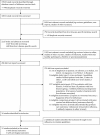Effectiveness of influenza vaccines in adults with chronic liver disease: a systematic review and meta-analysis
- PMID: 31494620
- PMCID: PMC6731888
- DOI: 10.1136/bmjopen-2019-031070
Effectiveness of influenza vaccines in adults with chronic liver disease: a systematic review and meta-analysis
Abstract
Objectives: Patients with liver disease frequently require hospitalisation with infection often the trigger. Influenza vaccination is an effective infection prevention strategy in healthy and elderly but is often perceived less beneficial in patients with liver disease. We investigated whether influenza vaccination triggered serological response and prevented hospitalisation and death in liver disease.
Design: Systematic review and meta-analysis.
Data sources: MEDLINE, EMBASE, PubMed and CENTRAL up to January 2019.
Eligibility criteria: Randomised or observational studies of the effects of influenza vaccine in adults with liver disease.
Data extraction and synthesis: Two reviewers screened studies, extracted data and assessed risk of bias and quality of evidence. Primary outcomes were all-cause hospitalisation and mortality. Secondary outcomes were cause-specific hospitalisation and mortality, and serological vaccine response. Random-effects meta-analysis was used to estimate pooled effects of vaccination.
Results: We found 10 041 unique records, 286 were eligible for full-text review and 12 were included. Most patients had viral liver disease. All studies were of very low quality. Liver patients both with and without cirrhosis mounted an antibody response to influenza vaccination, and vaccination was associated with a reduction in risk of hospital admission from 205/1000 to 149/1000 (risk difference -0.06, 95% CI -0.07 to 0.04) in patients with viral liver disease. Vaccinated patients were 27% less likely to be admitted to hospital compared with unvaccinated patients (risk ratio 0.73, 95% CI 0.66 to 0.80). No effect against all-cause or cause-specific mortality or cause-specific hospitalisation was found.
Conclusions: The low quantity and quality of the evidence means that the protective vaccine effect may be uncertain. Considering the high risk of serious health outcomes from influenza infection in patients with liver disease and the safety and low cost of vaccination, overall, the potential benefits of seasonal vaccination both to patients and the healthcare systems are likely to outweigh the costs and risks associated with vaccination.
Prospero registration number: CRD42017067277.
Keywords: cirrhosis; hospitalisation; influenza vaccine; liver disease; seroprotection; vaccine effectiveness.
© Author(s) (or their employer(s)) 2019. Re-use permitted under CC BY. Published by BMJ.
Conflict of interest statement
Competing interests: None declared.
Figures






Similar articles
-
The effectiveness of influenza vaccination in pregnancy in relation to child health outcomes: Systematic review and meta-analysis.Vaccine. 2020 Feb 11;38(7):1601-1613. doi: 10.1016/j.vaccine.2019.12.056. Epub 2020 Jan 10. Vaccine. 2020. PMID: 31932138
-
Influenza vaccine effectiveness in hospitalised Hong Kong children: Feasibility of estimates from routine surveillance data.Vaccine. 2018 Jun 7;36(24):3477-3485. doi: 10.1016/j.vaccine.2018.04.081. Epub 2018 May 5. Vaccine. 2018. PMID: 29739719
-
Effectiveness, immunogenicity, and safety of influenza vaccines with MF59 adjuvant in healthy people of different age groups: A systematic review and meta-analysis.Medicine (Baltimore). 2020 Feb;99(7):e19095. doi: 10.1097/MD.0000000000019095. Medicine (Baltimore). 2020. PMID: 32049815 Free PMC article.
-
Immunogenicity, safety, and effectiveness of seasonal influenza vaccination in patients with diabetes mellitus: A systematic review.Hum Vaccin Immunother. 2018;14(8):1853-1866. doi: 10.1080/21645515.2018.1446719. Epub 2018 Apr 9. Hum Vaccin Immunother. 2018. PMID: 29517396 Free PMC article.
-
Impact of influenza vaccination on healthcare utilization - A systematic review.Vaccine. 2019 May 27;37(24):3179-3189. doi: 10.1016/j.vaccine.2019.04.051. Epub 2019 Apr 30. Vaccine. 2019. PMID: 31047677
Cited by
-
Approaches for Selective Vaccinations in Cirrhotic Patients.Vaccines (Basel). 2023 Feb 16;11(2):460. doi: 10.3390/vaccines11020460. Vaccines (Basel). 2023. PMID: 36851337 Free PMC article. Review.
-
Liver Injury in Patients with Coronavirus Disease 2019 (COVID-19)-A Narrative Review.J Clin Med. 2021 Oct 28;10(21):5048. doi: 10.3390/jcm10215048. J Clin Med. 2021. PMID: 34768568 Free PMC article. Review.
-
Vaccination in liver diseases and liver Transplantation: Recommendations, implications and opportunities in the post-covid era.JHEP Rep. 2023 Apr 26;5(8):100776. doi: 10.1016/j.jhepr.2023.100776. Online ahead of print. JHEP Rep. 2023. PMID: 37360567 Free PMC article. Review.
-
Impact of COVID-19 vaccination on liver transplant recipients. Experience in a reference center in Mexico.PLoS One. 2024 Mar 28;19(3):e0301198. doi: 10.1371/journal.pone.0301198. eCollection 2024. PLoS One. 2024. PMID: 38547193 Free PMC article.
-
Immunogenicity of COVID-19 vaccines in patients with cirrhosis: A meta-analysis.Hum Vaccin Immunother. 2024 Dec 31;20(1):2326316. doi: 10.1080/21645515.2024.2326316. Epub 2024 Mar 11. Hum Vaccin Immunother. 2024. PMID: 38466197 Free PMC article.
References
-
- GBD 2016 Disease and Injury Incidence and Prevalence Collaborators Global, regional, and national incidence, prevalence, and years lived with disability for 328 diseases and injuries for 195 countries, 1990-2016: a systematic analysis for the global burden of disease study 2016. Lancet 2017;390:1211–59. 10.1016/S0140-6736(17)32154-2 - DOI - PMC - PubMed
Publication types
MeSH terms
Substances
Grants and funding
LinkOut - more resources
Full Text Sources
Medical
